International Journal of Astronomy and Astrophysics
Vol.1 No.1(2011), Article ID:4374,5 pages DOI:10.4236/ijaa.2011.11003
Space Weather – Sun Earth Relations
Indian Institute of Astrophysics Kodaikanal, India
E-mail: ksrnkodai@yahoo.co.in, sundar@iiap.res.in
Received February 22, 2011; revised March 1, 2011; accepted March 4, 2011
Keywords: Sun, Sunspot, Prominence, Solar Flare, Coronal Mass Ejection
Abstract
Sun, a star of spectral type G2 is the main source of energy to the Earth. Being close to the Earth, Sun produces a resolvable disk of great detail, which is not possible for other stars. Solar flares and coronal mass ejections are the enigmatic phenomena that occur in the solar atmosphere and regularly bombard the Earth’s environment in addition to the solar wind. Thus it becomes important for us not only to understand these physical processes of the Sun, but in addition how these activities affect the Earth and it’s surrounding. Thus a branch of study called “Space Weather” had emerged in the recent past, which connects the Sun Earth relations. This paper details about the solar activity and associated energetic phenomena that occur in the atmosphere of the Sun and their influence on the Earth.
1. Introduction
Sun is a star of spectral type G2. It is located at a distance of 20,000 light years from the centre of our galaxy “Milky Way”. It is an average star among 100 billions stars of our galaxy. Its close proximity to the Earth makes us to study the Sun in great detail, which is not possible for other stars. When seen from the distance of our neighbouring star Alpha Centauri, Sun would be just a point source in the sky. However, from our vantage point, it is possible for us to see how this jewel of star is made of and the interesting activities that take place in its atmosphere. More interestingly due to the advent of technology, it is now possible for us to even look inside the Sun and probe what is going on inside our star through the study of helioseismology. The Sun warms us, nurtures our crops, and influences our weather. It is, literally, the most important celestial object for the mankind.
We will come across various interesting features when we look into the surface and atmosphere of the Sun. Though to a certain extent, we could understand the formation and rhythmic cycle of the magnetic activity, still lot a more has to be understood from the solar activity and associated physical processes. Solar storms or flares [1,2] are associated with the magnetic activity and produce deadly ultraviolet light, X-rays and throw radiation of all kinds. A medium sized flare can release energy equivalent of a billion megatons of TNT in a few minutes. Solar astronomers are trying to understand the energy storing mechanism involved in such events. It is also interesting to find out how this energy is suddenly released. Another curious phenomenon is the mass ejections that occur almost every day from the outer solar atmosphere. We still have fuzzy ideas on how such a huge amount of mass made up of electrified plasma is expelled from the Sun. It becomes highly important to study and probe completely these violent phenomena in order to avert some of the huge damages that we may come across during the course of such events. The next question that constantly strikes the mind is the continuous flow of solar wind at speeds as high as 1000 km/s. This gusty wind produces auroras and geomagnetic storms, events in which the Earth’s magnetic field takes a terrific buffeting. Still we don’t know how the solar wind is accelerated to such high speeds. The aspect of study linking the Sun-Earth relations is called ‘Space Weather’ and it forms the interesting topic of this paper.
2. Why to Study the Sun
As soon as the sun rises, the entire sky is washed away by the sunlight making it to appear as a “super star”. It subtends an angular dimension of slightly more than half a degree and presents itself a resolvable disk of high intensity. Sun is at its young age now, spent 4.25 billion years and it will survive for another 6 billion years before ending its life as a “white dwarf” [3].
Sun emits radiation in all possible wavelengths or frequencies ranging from high energy gamma rays to low energy radio waves and pours light in all directions. Earth has a tenuous atmosphere spreading into thousands of kilometers above the surface, and this atmosphere is shielding the hazardous high energy radiation from the Sun reaching the Earth. The atmosphere of the Earth allows only the visible and radio parts of the spectrum. To study the Sun in X-ray or in some other wavelengths we need space bound observatory. The factors such as Earth’s climate connection, Space Weather, Sun as a Star and Sun as a physical laboratory make us to become more inquisitive to study the Sun.
3. Solar Atmosphere
Since Sun is a huge and high dense ball of gas, it is not possible to probe directly the physical condition in the interior of the Sun. However, it is possible to study these structures from the minute vibrations of the Sun’s surface, as Sun oscillates at different frequencies [4]. The aspect of study to understand the interior structure of the Sun is called “Helioseismology”. The internal metabolism of the Sun is not just a passive lump of gas. Sun has a hard core followed by a misty radiative zone which is enveloped by an interesting convection zone where it works as a powerful generator [5]. This dynamo action makes the Sun as an interesting object of study as it produces solar activity, some of which still pose challenging questions to be resolved. The atmosphere of the Sun is divided into three sections, namely photosphere, chromosphere and corona.
Photosphere: The surface of the Sun is called “photosphere”, the region from where the photons start their journey into space in the form of electromagnetic radiation. As Sun is a ball of gas, its surface is not uniform like that of the rocky Earth. The photosphere extends up to around 100 km. By projecting the Sun on to a screen or a wall through a telescope, we can see the white light image of the Sun.
“Sunspots” are observed when Sun is seen in white light. Sunspots are strong magnetic field regions [6] in the solar atmosphere. These regions are cooler compared to the surrounding and appear darker. The strong magnetic fields of a sunspot exert pressure on the gas trapped beneath and prevent from reaching the surface and also shield the sunspot from the surrounding hot regions. The big spot that appears in Figure 1 may be 30 times the size of the Earth. Sunspots wax and wane once in 11 years as their number keeps changing from one day to the next. This is called “sunspot cycle” or “solar cycle”. The right frame of the Figure 1 shows the Sun during its minimum period and the sun in this period is called “Quiet Sun”. Sunspots generally appear within 40 de-
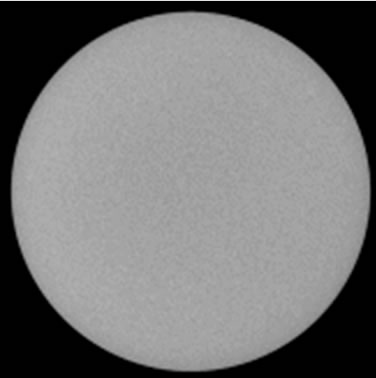
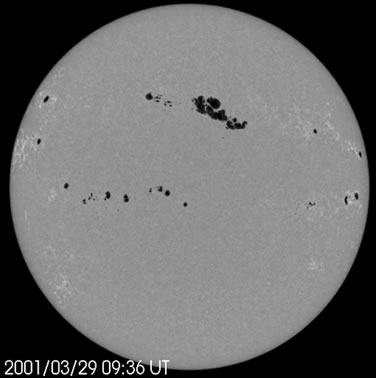
Figure 1: Sun in white light shows the “photosphere”. The left side of the image shows the presence of “sunspots”. The picture in the right frame shows the Sun without sunspots. The red colour of the image is due to the filter used while taking the pictures.
grees in latitude on both sides of the solar equator. Sun also has a self rotation like the Earth, but rotates faster in the equator than in the poles. It has 25.1 days of rotational period in the centre and 34.4 days in the poles. This differential rotation coupled with the convection is thought to be responsible for the formation of sunspots. Sun is now in its 24th solar cycle.
Chromosphere: The next atmosphere of the Sun above the photosphere is called “chromosphere”. Just before the total solar eclipse, the pinkish chromosphere will appear.
As the strong spectral lines H alpha and Ca K are of chromospheric origin, taking the picture of the Sun with the help of a spectrograph or with a narrow band filter in these wavelengths will show the chromospheric details. Figure 2 shows the image of the Sun in H alpha and Ca K. The bright and dark features appear on the images are the magnetic features. The dark thread like feature in H alpha is called “filament”. It is a dense gas of low temperature.
The bright regions are called “plages”. The intense sunspots are visible in these pictures too but they are of photospheric origin. Due to the solar rotation, the dark “filaments” appear brighter as “prominences” when they are near the limb. The prominences are hot plumes of gases suspended due to its magnetic shield [7]. Some-
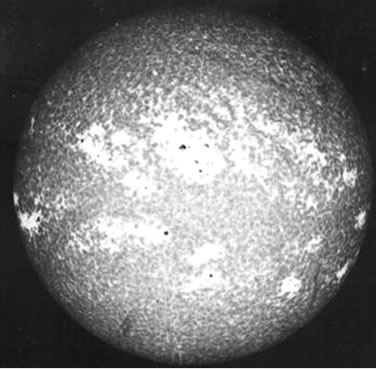
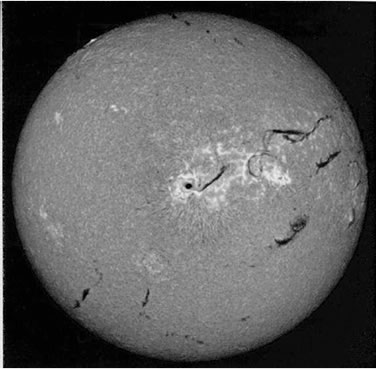
Figure 2. Chromspheric images of the Sun in H alpha and Ca K light.
times, these prominences erupt and become “active”. The eruptive material can cause geo magnetic effects. The thickness of the chromosphere is approximately 10,000 km.
Corona: Corona is the outer atmosphere of the Sun. It is visible during the total solar eclipse. The name comes from Latin, meaning “crown”. When Moon comes exactly in between the Earth and the Sun, the total eclipse takes place and corona is visible.
Figure 3 shows the Solar Corona in white light observed from Chongqing, South West of China on 22 July 2009. The temperature goes to 1-5 million degree from low to high solar corona. The right frame of Figure 3 shows the X-ray picture of the solar corona photographed by the Japanese Satellite “YOHKOH”. The bright regions are called “Coronal Loops” which are the active regions observed in the corona. The dark region is called “Coronal Hole”. Solar coronal holes are regions of cool and low density plasma that appear dark at coronal temperatures of million degrees. These regions predominantly possess unipolar magnetic field, from where the fast solar wind originates. MHD waves are considered to be the heating process of solar corona and acceleration of fast solar wind.
4. Solar Storms and Coronal Mass Ejections
Solar Flares: Solar Flares or storms are energetic phenomena that occur in the solar atmosphere. Basically they are coronal phenomena. They are explosions in magnetized plasma. In a matter of just few minutes, the localized region in the solar atmosphere is heated to many million degrees and energy as high as 1032 ergs/s will be suddenly released. They are always associated with one or more active regions. They generally occur above sunspots, usually along the dividing line (neutral line) between areas of opposite polarity [8]. Flares observed in the visible part in H alpha are called low temperature flares.
High temperature flare is visible in EUV occurring in transition region, and in X-ray, Radio in coronal level. They form 20,000 km from the base of the photosphere. Apart from some of the exceptional events, flares are not observed in integrated white light. Optical flares are mostly observed in H alpha as brightening of plages with a fast increase in brightness followed by a much slower decay. Figure 4" target="_self"> Figure 4 shows the flares observed in H alpha and EUV. Common to all the flares is the heating of the restricted parts of the chromosphere and corona. This particular aspect of the flare is called “Thermal Flare”. When the flare is so powerful, acceleration of particles can take place, and electrons accelerated to energies as high as MeV are detected. Some times even proton events are also observed when they are accelerated to
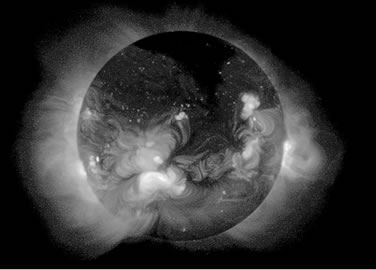
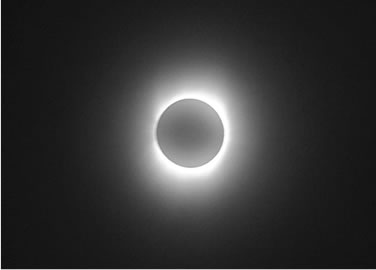
Figure 3. Solar Corona observed during eclipse. X-ray Sun showing Coronal features.
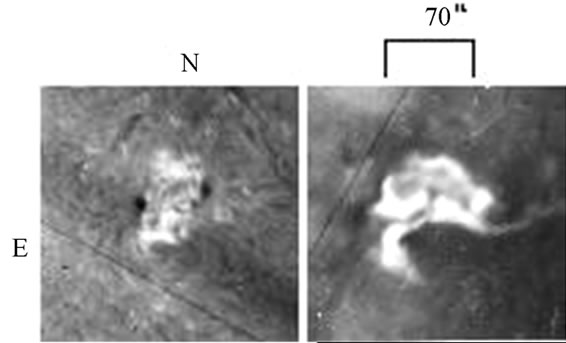

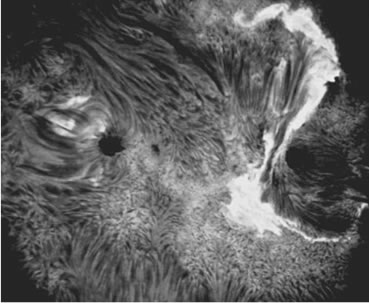
Figure 4. Flares observed at Kodiakanal in H alpha. The image in green shows flare in EUV (SOHO).
energies of the order of GeV. This aspect of the release of kinetic energy is called “Non thermal flare”.
Primary condition for a flare to occur is the presence of one or more active regions like sunspots in the photosphere, plages or filaments in the chromsophere or bright coronal loops. These active regions are deep anchored in the photosphere or even below. Gradually energy is getting accumulated in the active region magnetic fields before sudden eruption. The energy available at the time of explosion must be derived from the magnetic fields of the active regions, because other energy sources are totally inadequate in the solar atmosphere. Now it has been realized that flares derive their power from the stressed magnetic fields of the active regions [9]. Figure 5 shows the sunspot belonging to the active region (AR) NOAA 10486 observed at Kodaikanal during October 2003 gradually growing into a big group. As the sunspot grows in size, the magnetic fields of the active region get severely twisted from the incoming flux. The figures in H alpha show the flares observed in the same active region on different dates during the course of development of this complex sunspot group. As the sunspot grows, it is observed that the sunspot motions [10] play a vital role in twisting the magnetic fields of the active region. The emergence of magnetic flux from below is responsible
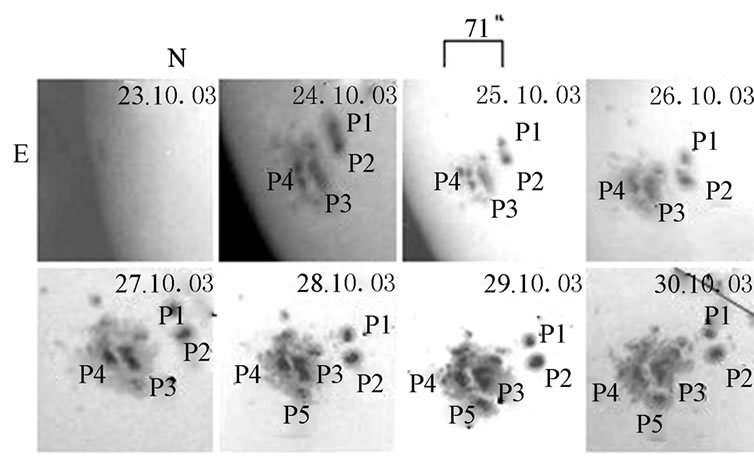

Figure 5. AR NOAA 10486 observed at Kodaikanal during October 2003 (top) and the flares erupted in the regions shown below in H alpha.
for the sunspot growth. Figure 5 shows two sunspot groups P1, P2 and P3, P4. As the sunspots start growing in size from one day to the next, there is a change in their orientation. This change in the orientation indicates the sunspot motions. The magnetic fields of the sunspots in this way get severely twisted due to their growth or motions. The magnetic energy thus gets stored in the form of twisted magnetic fields. Once the twist exceeds a critical value, the stored energy gets released as a storm or flare. Factors such as emergence or decaying of magnetic flux in sunspots, plage or filament motions are essentially responsible for the magnetic stress to be accumulated in the active regions. The stored magnetic energy is converted into thermal and kinetic energy at the time of the flare. Earth directed flares may create strong geo magnetic effects.
Coronal Mass Ejections: Large coronal loop shaped eruptions having diameter more than 2 solar radii moving away from the Sun were discovered in the early 1970s from the “skylab” coronograph observations and are called “coronal transients” [11]. Because, these events are often associated with flares, they are thought to be the consequences of the solar flares. Now it has been made clear that an H alpha or X-ray flare is not a necessary condition for a “Coronal Mass Ejection” [12]. The sky lab results clearly show that the CMEs are the eruptions of coronal material that flows with a very high speed solar wind causing geomagnetic effects. The CMEs are observed to be a process in which transport of mass as high as 200 million tons of plasma per second at speeds ranging up to 1000 km per second take place. They comprise roughly one tenth of coronal material with energies as high as 1032 ergs/s. At times a flare produces mostly thermal energy, whereas CMEs are bulk motions in the form of kinetic energy [13]. The main driver of the CME or flare is a large scale reorganization of the coronal magnetic fields [12,14]. Figure 6" target="_self"> Figure 6 shows the CMEs.
The frequency of occurrence of the CMEs is observed as at least one event during solar minimum and a maximum of 6 events during solar maximum. They are mostly associated with flares and prominence eruptions. The highly ionized plasma ejected during the CME takes 3-4 days to reach the Earth. Although, CMEs present variety of appearances, including loops, clouds and amorphous plasmoids, typically they consist of three components, a bright leading shell of material surrounding a dark cavity within which an erupting prominence is seen [15]. They are often seen in conjunction with the radio emissions type II and type IV bursts. CMEs aimed at Earth are called “halo events” because of the way they look in coronograph images. As the expanding cloud of an Earth-directed CME looms larger and larger, it will appear to envelop the Sun, forming a halo around our star. The many speckles observed in the disc of the CME pictures are the particles that are bombarding the occulting disc in the detector of a spacecraft like SOHO that is monitoring the coronal phenomena.
5. Summary-Space Weather-Geo Effects of Solar Activity
Space Weather refers to the violent transfer of energy and particles from the Sun to the Earth. The radiation takes slightly more than 8 minutes to reach the Earth whereas the particle events may take 3-4 days. Because of the high energy radiation, the communication systems, satellite operations and navigation might be disturbed immediately. The particle events may take days to affect the space shuttle and space station activities. High altitude polar flights and the persons on board will be affected. The astronauts on space will be exposed to high dose of radiation and energetic particles. Earth’s ionosphere will be getting affected with a storm and long dis-


Figure 6. CMEs. The right frame shows artist imagination of the CME reaching the Earth.
tance radio communication will be disturbed. When such energetic events arrives the Earth, it may carry millions of volts and hundreds of thousands of amperes of current. The event will be able to permanently damage the electric power distribution system in the high latitude belts. Long distance telephone communications through cable distribution and GPS operations will be disturbed. Once the energetic particles from these events reach the Earth, they will interact with our atmospheric particles and produce colourful skies that are known as “auroras” and are mostly observed in high latitude regions. These factors make us to study and act immediately to avert the damages that may be caused due to these events.
Therefore, understanding the solar magnetic fields becomes highly important in the present scenario. We have to develop realistic models of the flares and CMEs. Watching the Sun continuously and analyzing the solar data constantly would make predictions of such events. Once these events are predicted, there should be quick communication to the technological systems, which may get damaged due to solar particle events. Since Sun is by far the largest supplier of energy to the Earth, any change in the energy output of the Sun will affect the energy balance of the Earth. Thus, it becomes important for us to study and understand the physical processes that take place on the Sun.
6. Acknowledgements
I extend my sincere thanks - courtesy to NASA for reproducing some of the pictures that appear in this paper. I thankfully acknowledge the referee for the kind comment in accepting this paper as a research article.
7. References
[1] R. C. Carrington, “Description of a Singular Appearance Seen in the Sun on September 1, 1859,” Monthly Notices of Royal Astronomical Society, Vol. 20, November 1859, pp. 13-15.
[2] R. Hodgson, “On a Curious Appearance Seen in the Sun,” Monthly Notices of Royal Astronomical Society, Vol. 20, November 1859, pp. 15-16.
[3] S. Chandrasekhar, “The Maximum Mass of Ideal White Dwarfs,” Astrophysical Journal, Vol. 74, No. 1, July 1931, pp. 81-82. doi:10.1086/143324
[4] H. Zirin, “Astrophysics of the Sun,” Cambridge University Press, Cambridge, 1988.
[5] R. J. Bray and R. E. Loughhead, “Sunspots,” Chapman and Hall, London, 1964.
[6] G. E. Hale, “On the Probable Existence of a Magnetic Field in Sunspots,” Astrophysical Journal, Vol. 28, November 1908, pp. 315-347.
[7] E. R. Priest, “Dynamics and Structure of Quiescent Prominences,” Kluwer Academic Publications, Dordrectht, 1989.
[8] A. B. Severny, “Solar Flares,” Annual Review of Astronomy Astrophysics, Vol. 2, September 1964, pp. 363-400.doi:10.1146/annurev.aa.02.090164.002051
[9] Z. Svestka, “Solar Flares”, D. Reidel Publishing Company, Dordrecht, Holland, 1976.
[10] K. S. Raman, R. Selvendran and R. Thiagarajan, “Sunspot Motions Associated with Flares,” Solar Physics, Vol. 180, No. 1-2, June 1998, pp. 331-341. doi:10.1023/A:1005058825136
[11] R. M. MacQueen, J. A. Eddy, J. T. Gosling, E. Hildner, R. H. Munro, G. A. Newkirk Jr., A. I. Poland and C. L. Ross, “The Outer Solar Corona Observed from Skylab: Preliminary Results,” Astrophysical Journal Letters, Vol. 187, January 1974, pp. 85-88. doi:10.1086/181402
[12] S. W. Kahler, “Solar Flares and Coronal Mass Ejections,” Annual Review of Astronomy Astrophysics, Vol. 30, January 1992, pp. 113-141.doi:10.1146/annurev.aa.30.090192.000553
[13] B. C. Low, “Magnetohydrodynamic Processes in the Solar Corona-Coronal Mass Ejections and Magnetic Helicity,” Plasma Physics, Vol. 1, May 1994, pp. 1684-1690.
[14] J. T. Gosling, “The Solar Flare Myth,” Journal of Geophysical Research, Vol. 98, No. 11, November 1993, pp. 18937-18950. doi:10.1029/93JA01896
[15] A. J. Hundhausen, “The Origin And Propagation Of Coronal Mass Ejections,” Proceedings Sixth International Solar Wind Conference, Colorado, 1988, pp.181-186.

